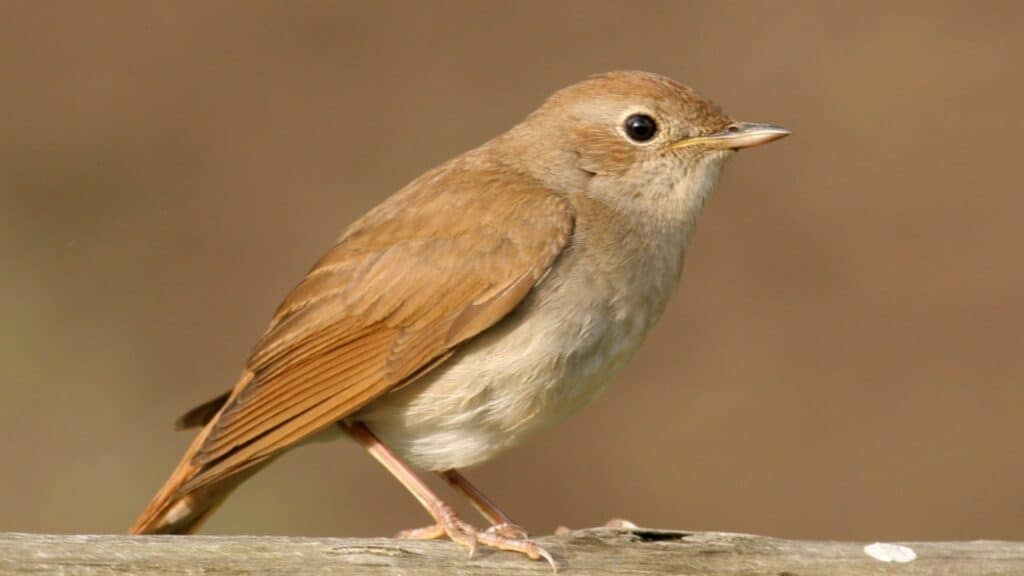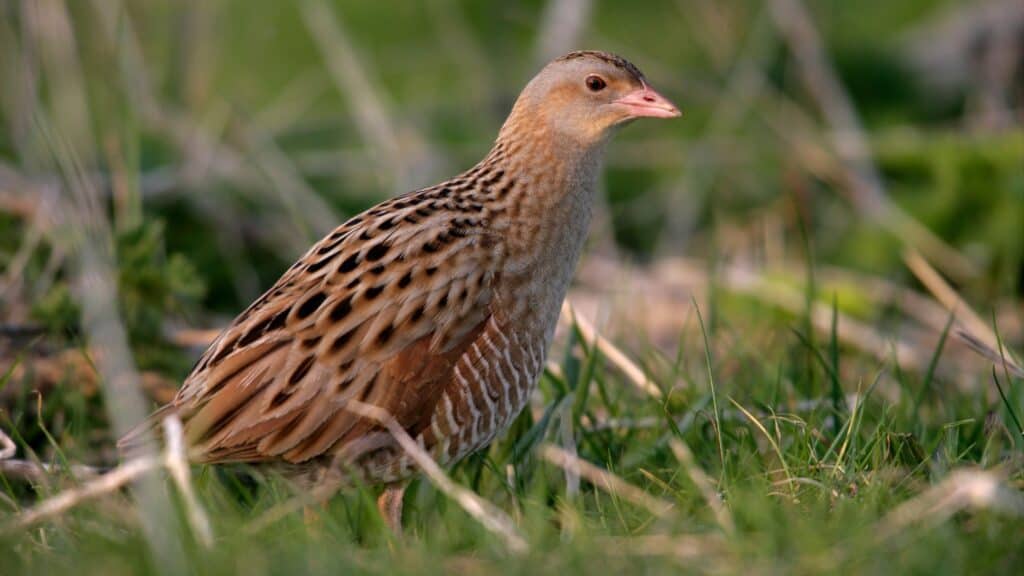Cheerful chirping at the crack of dawn is often what comes to mind when describing songbirds. However, a nocturnal subset of songbirds also exists. These nocturnal songbird species are responsible for creating the music that comes in the darkness of night.
Here are 5 common UK birds that sing at night:
- Robins
- Nightingales
- Dunnock
- Corncrakes
- Nightjars
In this article, I’ll review these common types of nocturnal UK songbirds. This will include how to identify these species, why they sing at night and other unique characteristics of each.
1. Robins
One of the most common culprits of nighttime singing in the United Kingdom is the Robin. Robins make up a significant portion of the bird population in the UK, with a population of nearly 7 million. These birds sing at night in all seasons, even throughout the winter. Robins do not migrate and can be found in residence in the UK year-round.
Both male and female Robins look the same and can easily be identified by their bright redbreasts. However, younger Robins may not have developed the signature redbreast yet instead have a golden brown colour.
| Robin | Figures |
| Length | 14cm (.4in) |
| Wingspan | 20-22cm (7.9-8.7in) |
| Weight | 14-21g (.49-.74oz) |
The Robin eats a variety of things, including worms, seeds, fruits, insects, and other invertebrates. When gardening, you may notice Robins following you, looking for worms that may be unearthed. Their favourite foods are mealworms and beetles.
Robin song
If you have a larger garden or are located near flat land, the sound of Robins singing at night may be amplified as they’re eagerly seeking out food in the soil. They’re also likely to search for food in flower beds or where the grass is sparse so they can easily reach the soil quicker.
What Do Robins Sound Like?
A Robin’s song usually consists of several high pitches, drawn-out notes that quickly increase speed while descending in pitch. Thus, it can be described as wistful but upbeat, with some allowance for pauses between the verses.
The song of a Robin may sound pleasant to the human ear but is actually frequently intended to be a warning song to ward off other birds from their territory.
Why Do Robins Sing at Night?
Robins often use songs as a way to warn other birds to avoid their territory. Robins are very confrontational and aggressive, with life spans thought to be negatively affected by their frequent clashes. Additionally, the song is also used to attract a mate during breeding seasons.
Robins sing year-round, including during the winter. They are often one of the first birds to start singing in the morning at daybreak and one of the last to finish in the evening. They may increase singing frequency during the spring for breeding seasons, as they actively try to attract mates.
Robins are well-acclimated to singing in low light environments. Places that possess street lamps or other sources of artificial light can trigger Robins singing during the night for this reason. During off-seasons, their singing may decrease in frequency but will continue as they shift the focus of their singing back to defending their territory.
See also: How long do Robins live?
2. Nightingales

Unsurprisingly, the Nightingale is another of the most common feathered culprits for singing at night in the UK due to their name. In addition, the Nightingale’s distinct, very vocal nature makes it one of the most famous songbirds of any time of day.
Nightingales are a bit larger than Robins, but they lack the distinctive redbreast. Instead, Nightingales present a rather plain, brown-coloured appearance with a broad tail. They may have a reddish tail and some cream or white colouration as well, with pink legs.
| Nightingales | Figures |
| Length | 15-17cm (5.9-6.7in) |
| Wingspan | 23-26cm (9-10.2in) |
| Weight | 17-24g (.6-.85oz) |
Nightingales mainly feed on insects. They are particularly fond of ants and beetles. These birds feed by foraging on the ground. Nightingales generally prefer to stay hidden in brush or other covered areas, so this feeding pattern is conducive to their ability to stay hidden.
Nightingale song
Nightingales may also supplement with berries and other fruits. They generally come out to feed during the day to replenish their nutritional reserves to fuel their passionate nighttime song making.
What Do Nightingales Sound Like?
The famous song of the Nightingale entails a fast succession of high, low, and rich notes few other birds can match, along with a characteristic loud whistling crescendo. Nightingales are thought to have more than 200 songs in their repertoire, offering significant variety to their songs.
Male nightingales do the singing for this species, as opposed to the females often portrayed in stories. In addition, they often sing even louder in urban or near-urban environments in an effort to be heard over the background noise. So, if you live in a busy neighbourhood or near a main road and hear a bird singing at night, chances are, it is probably a Nightingale.
Why Do Nightingales Sing at Night?
Only unpaired male Nightingales sing at night when migrating females fly overhead. Nightingales singing at dusk are defending their territory from other bird intruders. The Nightingale loves to sing and can often be heard for long periods of time and at great distances.
Due to their increased singing frequency during mating season, the best time to hear Nightingales is May to early June. However, if you want to hear singing Nightingales during the breeding season, your best bet is a trip to the South East – Essex, Suffolk, Norfolk, Kent, and Sussex, where they are heavily concentrated.
Nightingales are nocturnal birds, so they sing at night, but they also sing in the morning and throughout the day. Nightingales summer in the UK and then head south to Africa during colder seasons. They appear in the UK in April and leave in July or August.
3. Dunnock
Another less common bird species that may sing at night is the Dunnock.
The Dunnock is a small sparrow-like bird with brown and black streaks with a lead-grey head and thin, dark beak. They possess either brown or pink legs. Young Dunnocks have lighter coloured bills and lightly speckled feathers before developing into their adult colouration.
| Dunnock | Figures |
| Length | 14cm (5.5in) |
| Wingspan | 19-21cm (7.5-8.3in) |
| Weight | 19-24g (.67-.85oz) |
Dunnocks are mainly insectivores. They rely on insects, spiders, worms, seeds, and berries for nourishment. Dunnocks tend to prefer being hidden on the ground versus being in the air, so they choose food sources that they can forage for on the ground.
Since these birds are ground-based feeders, it is not uncommon to find them searching for small bugs in hedges and bushes.
Dunnock song
If you’re situated near several trees, bushes, or shrubbery, you’re likely to hear Dunnocks within range as they search for their food.
See also: What is the difference between Sparrow and Dunnock?
What Do Dunnocks Sound Like?
A Dunnock makes a trill that sounds a bit like a rotating squeaky wheel. They often make songs with a long verse of three to four seconds that is fast and squeaky without pauses or pace changes.
A Dunnock’s song usually demonstrates a series of rushed phrases and is less melodious than a robin. If alarmed, they emit a single, flat piping note.
Why Do Dunnocks Sing at Night?
One of the main reasons Dunnock’s sing is for territory marking and defence against other birds. Additionally, Dunnocks are also vocal for interaction within close range between individual birds. Both the male and female Dunnock use songs to communicate.
Dunnocks generally sing from early in the year, around late January onwards through July, with peak March. However, they can usually be found year-round in the UK.
Songs at close range tend to be shorter and lower volume than those used for defensive purposes. When rival male Dunnocks meet, they can also become very animated and use loud calling in conjunction with a lot of wing-flicking to intimidate their opponent. Female Dunnocks similarly use vocalization to compete for the males.
Similar to other species, low light intensities can trigger evening and early morning songs in Dunnocks. Artificial light from cities creates dim light levels and is a common reason for Dunnocks to extend their singing periods into nighttime when marking their territory.
4. Corncrakes

Corncrakes can be identified by their bright chestnut wings with brown or pink trailing legs.
| Corncrakes | Figures |
| Length | 27-30cm (10.6-11.8in) |
| Wingspan | 46-53cm (18.1-20.9in) |
| Weight | 120-200g (4.2-7.1oz) |
Corncrakes are relatively small, being only slightly bigger than the common blackbird.
Corncrakes prefer to spend the majority of their time hidden in tall vegetation. They rely on sustenance from insects and seeds they find while remaining hidden in their desired breeding habitats of cornfields and grassland. They may also eat small frogs and mammals, as well as plant material.
Corncrakes song
Since Corncrakes enjoy hiding in tall vegetation, hearing them in the fields and near forestry is more common than near busy roads or packed estates. You probably won’t hear them as often if you’re located inside the city, where land is limited.
What Do Corncrakes Sound Like?
A male Corncrake generally uses a loud, repetitive, grating sound that is noticeable from 1.5km (.93m) away. A female Corncrake uses a similar raspy breeding call, with a barking tone of similar rhythm but less grating than a male. Females will also coo to their young chicks.
Why Do Corncrakes Sing at Night?
The Corncake utilizes its vocal prowess for the main purpose of breeding. Their songs are used to attract mates. The powerful sound also carries for long distances to allow potential mates to locate other single birds.
Early in the breeding season, Corncrakes call almost continuously, often more than 20,000 times per evening. Peak hours are midnight to 3 am. The frequency decreases after the first few weeks of the season but may pick up again around the laying season and before the Corncrakes return to Africa.
5. Nightjars
Nightjars have a grey-brown, mottled, streaked, and barred plumage and possess pointed wings with long tails. Their legs are generally brown in colour.
| Nightjars | Figures |
| Length | 26-28cm (10.2-11in) |
| Wingspan | 7-64cm (22.4-26.4in) |
| Weight | 65-100g (2.3-3.5oz) |
Nightjars are also known to be largely insectivores. They feed on insects like moths and beetles. These birds are very agile in flight, which allows them to catch things like moths and other insects mid-flight.
They are fairly solitary birds and choose to hunt at dawn and dusk, as they are skilled at navigating low light situations. However, they can frequently be found in close proximity to livestock due to their attraction to insects in these environments.
Nightjar song
What Do Nightjars Sound Like?
You can usually determine that a nightjar is nearby based on the male’s song, which has a churring pattern that rises and falls in a way that almost mimics an illusion. The male’s song can contain up to 1900 notes per minute. They use this sound in conjunction with a distinctive whistling sound.
Why Do Nightjars Sing at Night?
Like other bird species, the Nightjar also utilizes song to attract a mate during the breeding season. Sometimes you can tell if a female is approaching because the male’s song will end with a bubbling trill or wing clapping. Females do not sing, but both sexes may call out the warning of a predator.
As nocturnal birds, Nightjars hunt at dawn and dusk and thus are frequently heard at these times. However, they are relatively inactive during the day, with most activity and song occurring during the hours of darkness.
Additionally, they are well-adapted to low light situations, so their singing times can be affected by artificial city lights similar to other species. Nightjars are also summer migratory birds and can be heard in the UK on warm, still summer evenings between April and August.
Other related questions asked
What does it mean when birds sing at night? As a general rule, birds sing at night to attract mates and inform other birds that this is their territory. Singing first thing in the morning and the last thing in the evening lets other competing birds know that the owner of this territory is still alive.
What is the first bird to sing in the morning? It is generally accepted that Robins are one of the first birds to sing each morning. However, the truth behind this is rather hard to prove given the regionality and species of bird that may be in your local vicinity. However, Robins are known to sing late in the evening and very early in the morning.
See Also
- What is the difference between Sparrow and Dunnock?
- Birds of Prey: South and South-East England
- What is the difference between Crow and Raven?
- What is the difference between Raven and Rook?
- Which birds murmurate?
